Hebrides Overture
We are finally publishing Dr. Big D’s travelogue from our Outer Hebridean Ice Cream Adventure. We also produced a short film about this trip that you can see here. Enjoy!
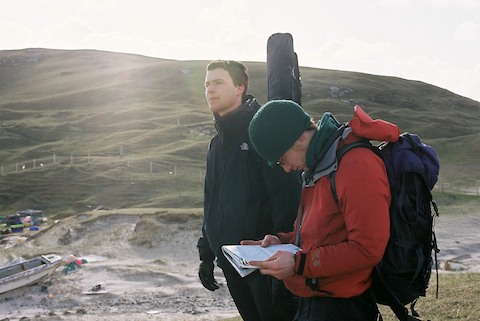
Why did we choose an ice cream adventure in the Outer Hebrides? Was it just to make life difficult for ourselves? You could argue that if that was the idea, we should have gone to Iraq, Nepal or China. Scotland on the other hand is the itinerant cranker’s dream. The sparse but widely dispersed communities mean that there’s an abundance of wee shops dotted around. Even if you’re not an ice cream maker, the basic ingredients of ice cream (cream, milk and sugar) are staples so most shops stock them. But what about the ice, you may ask? Well due to the popularity of frozen ready-meals most of these little shops also have freezers and many a modern Scot now quite likes an ice cube in his dram. Hence ice is also relatively easy to come by too. And who could resist holidaying in the stunning scenery of the Scottish islands especially in that perfect time of year when there is still daylight but the midges haven’t got going yet.
Day 1: Vatersay & Barra
So Thibault, Peter and I took a ferry to Barra. We left Oban in calm, cold weather. As we moved westwards the sea started to get rougher and rain clouds started to roll in. Every few minutes the ferry would ride up a bank of swell, pause in mid air, and then plunge down sending white spray crashing onto the windows of the observation deck. Barra appeared briefly on the horizon and then disappeared into the inky darkness as night fell. When the swell lessened we peered out into the black, hoping to catch a glimpse of the port. It had started raining. On the quay in Oban there had been lots of friendly chat between the various groups of cyclists and other tourists. There were no pleasantries now though. Everyone was focused on ensuring a bed for the night by being first to the one hostel or two hotels in Castlebay.
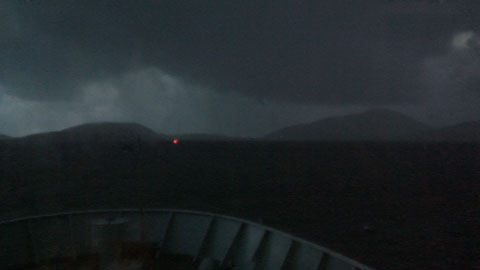
We were in less of a hurry; we had decided to camp instead of use hostels. Having carried the tent all the way to Barra and still feeling relatively fresh and well-rested, we were determined not to let a bit of weather deter us. As we cycled past the last streetlight into the dark, the rain turned to a stinging hailstorm. We made various forays onto the moorland looking for a campsite and found only bog. Then we passed an isolated house, with a flat patch of grass and gravel for a front garden. No car outside, windows all dark, but inside an assortment of furniture: decrepit, but not obviously abandoned. The only sign of life were the red digits on an alarm clock. Could someone actually be living here? If they were, they must be a recluse or stark raving mad or both. How did they survive? On a diet of beans and lost tourists maybe? Should we really risk a grizzly end by waking up a hermit at 11pm on a stormy night to ask permission to kip on his lawn? The alternatives were either sinking without trace into a peat bog or pitching up on the sly and wait to be murdered in our sleep. It was not a restful night. Within 12 hours of arriving on Barra we were soggy, tired and smelly. Only one thought had come to pre-occupy us – ice cream.
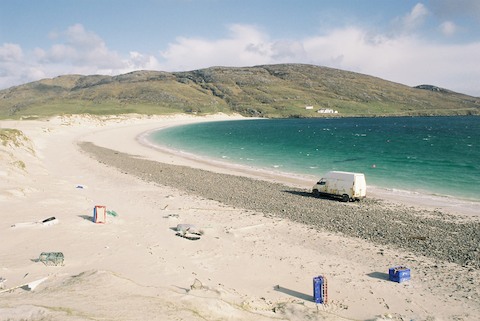
We booked into the local hostel to secure the requisite cooking facilities and then set off to the local Co-Op. As we bimbled down the aisles of the store picking up cream, milk and sugar I had a moment of epiphany by the hot beverages and realized Earl Grey tea would be a great flavour for ice cream. Standing in the queue to pay I got a surge of anticipation that something good was about to happen. Meanwhile a local lady spotted Thibault (and more specifically his banjo) and invited him (and, out of politeness, us) along to the pub to join in a folk music session with the locals. So we rushed back to the hostel cooked up the mix and set out (ice cream machine in hand) to the pub. If Peter and I couldn’t play music at least we could share our other skill. We only had a single bag of ice and hoped the pub would make up the shortfall so we could share our ice cream with the other musicians.
The bar was up a bank overlooking the bay and village. The afternoon sun streamed in through bay windows and there was a smell of warm upholstery. Five or six old sailors were sitting around a table each with their own accordion playing sea shanties and (of course) drinking. Initially I don’t think they knew what to do with Thibault, but they didn’t object when he started strumming along from the corner. Then there came a point where they were getting the next round in and one chap invited Thibault to play a tune and suggested we sing along. Now it must be said at this point that Peter and I are tone-deaf, so close harmony wasn’t really an option. We could however cook up reasonable renditions of old country tunes since the screeching, whining and intermittent growling which made up our attempts to sing were appropriate for the genre. Besides, we always felt they were meant to be sung from the heart so harmony wasn’t so important. So we served up a passable rendition of Woody Guthrie’s “Hard aint’t it hardâ€:
First time I seen my true love
He was walkin’ by my door
The last time I saw his false hearted smile
Dead on his coolin’ board
It’s hard and it’s hard ain’t it hard
To love one that never did love you
Hard and it’s hard ain’t it hard great God
To love one that never will be true
There is a house in this old town
That’s where my true love lays around
Takes other women right down on his knee
Tells them a tale that he won’t tell me
Don’t go to drinkin’ and to gambling
Don’t go there your sorrows to down
This hard-liquor place is a low-down disgrace
The meanest damn place in this town
…
We were encouraged by a little patter of appreciative applause and decided to sing some more. We sallied forth between our two little groups every 2-3 songs working our way steadily through the scraps of paper containing the collection of Woody Guthrie and Hank Williams, Sr. songs that Thibault had brought for the banjo. After glasses of whisky began to appear on our table, things started to sound better—though maybe not to our audience. When the guitarist who invited us finally showed up, Thibault was invited across to the circle and Peter and I proceeded to get gently pickled in the corner with one of the none musical ex-mariners. This great old sailor regaled us with stories about the merchant navy and the island in the old days.
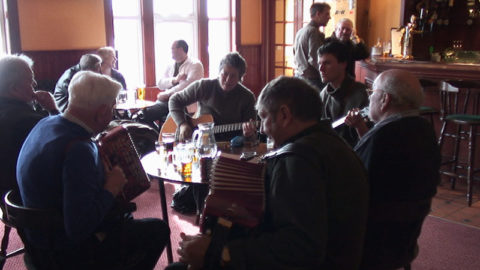
We would have dearly loved to make ice cream for our new friends but the landlord of the pub rather curtly told us we couldn’t bringing any food that “was not out of my kitchen†into the pub – sourpuss. So we decided to celebrate our evening back at the hostel. However on leaving the pub we discovered that in the time we had been getting pleasantly inebriated our ice was definitely on the melt. After stowing the remaining ice in the freezer, we set the ice cream machine on the front step ready for action and went off on a desperate mission to beg ice from the remaining pub and hotel to replenish our stocks. Returning triumphantly with ice in hand, our excitement was marred by disaster and mystery. We found the ice cream canister where we had left it, but it was empty! There was only a small drop of creamy goodness on the adjacent tarmac, and the crank was still safely locking down the top of the machine. Could someone have actually stolen the machine, drained (or even consumed) the contents and replaced the can? There were several suspects around: a group of teenagers skulked past, apparently disinterested, the village dog appeared from round a corner wagging his tail (altogether too pleased with itself if you ask me, but no ice cream stains under his fingernails – I checked). Could it even have been an ice cream abduction of the third kind? Whatever happened we were understandably upset. We exclaimed, stamped our feet and shook angry fists at the sky – was this some kind of test? Lightning flashed (metaphorically) and we knew what we had to do. When the going gets tough the tough make sorbet.
Four apples, two oranges (the only fruit we had available) and some sugar syrup later and we finally produced the long awaited dessert. Since ice cream is fundamentally a social food we shared it with our hostel-mates including a group of four girls who were also cycling south-north. The sorbet was not a gourmet delight – in fact it’s rather difficult to avoid a slightly fluffy texture with apple sorbet unless you use pressed juice. But flavour was not the point, we had come to the Hebrides to make iced desserts and by Jiminy we weren’t going to be thwarted by dogs, bogs, teenagers, weather, UFOs or divine intervention.
Day 2: Barra to South Uist
Wind is a defining characteristic of the Hebrides. The image of Ben’s face creased with laughter when I told him we were planning on cycling North-South along the Hebrides had had a big impression on me. The prevailing wind is South-Westerly. “We cycled South-North and some days didn’t even need to turn the pedals,†he said. Despite having already booked my flight to Stornoway, I nevertheless reasoned the cost of changing the flight was a fair price to pay for not spending seven days cycling into the wind. So it was something of a surprise to wake up in Barra to find the wind in a distinctly Northerly direction. It was no gentle breeze either, but a gale whistling down from the arctic like a screaming banshee, hurling buckets of rain and hail at us. In situations like this cycle touring requires true grit and some high gearing. Thibault probably had it hardest – the Banjo on his back was more than a rod for his own back. It was a sail insistently tugging him southwards again. We toiled up the West coast of Barra, accompanied all the way by the village dog from the previous night (called Kipper). I have no idea why he should decide that we were the people to follow around for the day. Maybe he was feeling guilty for lapping up an entire 1/2 gallon of ice cream mix the previous night? Or maybe he was hoping for a second serving! In any case he ran along side us the whole 7 miles to the Ferry to Eriskay at the north end of the island and kept us company for 3 hours whilst we waited for the tide to come in and let the ferry dock. We cooked up Puy lentils with bay leaves and kebanos in tge waiting room (giving a portion to Kipper of course), and I struggled to keep up with Thibault’s banjo chord changes on my little ukulele.
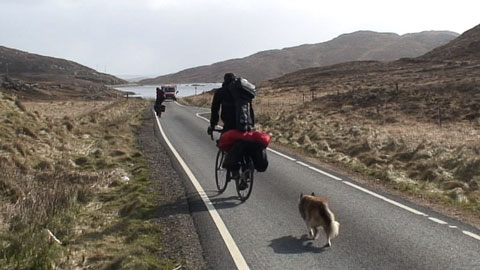
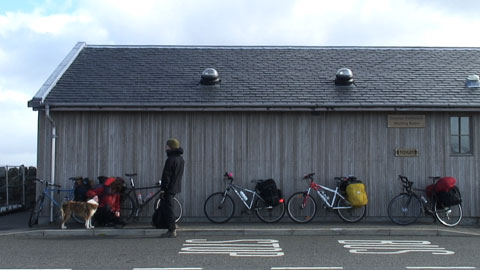
It was an emotional farewell as the ferry ramp went up, dividing us from the faithful Kipper who stood, disappointed and doe-eyed on the slipway. I hope he found someone to follow back to Castlebay.
I’m afraid I don’t remember much about Eriskay. There was wind and rain and hills and my world had contracted to the space between my nose and my bottom bracket. But I remember thinking of a song I used to know called the Eriskay Love Lilt, the verses of which went something like: (Play Midi)
Many wet and chilly nights,
I went [cycling] all alone,
Until I reached that place
The love of [ice-cream] found home.
There’s no music in my [banjo],
My fingers knew naught but pain,
Then your [ices], that wondrous barb,
Brought song to my life again.
Isn’t it marvellous how folk music can still resonate down the centuries?
I remember crossing the causeway to South Uist; the sun momentarily broke through the clouds turning the sea into a patchwork of blue and grey. Moments like that are what cycle-touring is all about.
South Uist is the end of the world, far more than Barra or any of the islands further north. The whole time I was there I was wondering: “What on earth are people doing trying to live here?†Nature has absolute control on the island; it is uncompromisingly desolate. The hill of Beinn Mhor seems to be just about pulling the south of the island out of the sea. The rest is just flat.
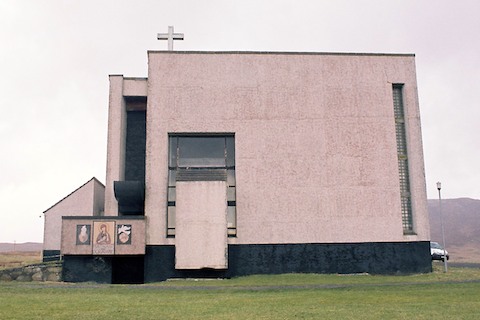
The youth hostel at Howmore is an old blackhouse and lies next to the site of a ruined 14th century church. The rain was holding off still when we arrived and daylight was starting to turn golden. It was a stunning scene, the flats, Beinn Mhor in the distance, a wind-scoured half-sunken Celtic cross in the churchyard. We went for a wander. I’m always moved by military graves. In a corner I found a well-kept headstone of a 19-year-old infantry private who died in the Great War. What could a war in Europe possibly have meant to the young men of a community out here that they left their families (who were no doubt depending on them to help scrape out an existence) to die? And what must they have thought when the body returned to be buried? There was no ice cream that night.

Day 3: The Uists, Benbecula & Harris
We had become a little disheartened by our slow progress at this point and resolved to lay some serious distance down. The last ferry of the day from North Uist to Harris was at 4pm, and we thought we could make it provided we didn’t stop too many times. We had to make an exception though when we passed a juicy fat Co-Op laden with ice, dairy and pastries. The weather had begun to improve, the wind dropped and cycling became a joy again rather than a test of endurance. I could easily wax lyrical about the countryside again but “we’ve got to be driftin’ along.”



The highlight of this day was the joy of physical exertion, sweat, rubber, tarmac, oil, clattering gears, that last few meters before your reach the top of a hill which always seems the hardest regardless of the gradient and the release when gravity starts to work for you and you slip down the other side.
Melt-water from the ice on the back of Peter’s bike slowly percolating through the cocoon of plastic bags dripped onto the tarmac, tracing our route through the Uists. We made the ferry, just, and booked into the multi-coloured youth hostel in Leverburgh on Harris.
After salvaging what remained of the ice, we set about the difficult process of matching ice cream to circumstance. In the same way food synergises with wine, ice cream resonates with the place it is made, the personalities of the makers, etc… Given the virtuous toil of the day and the peaceful atmosphere of Leverburgh, straight vanilla was the natural choice. We found a little spot overlooking the whole village and bay, and cranked whilst watching the sunset. It was fresh, clean, rich and more-ish. I don’t think third helpings ever seemed so natural.

Day 4: The beauty of Harris
We ambled north through Harris, which is probably the most classically picturesque of the Hebrides. It has a more compact beauty, more vertical drama in hills and coves compared to the sweep and horizontal charms of the Uists. It also has tweed – for which I have something of a passion (second to ice cream of course). One of the guys in the youth hostel had told us about several visits he had made to different weavers on the island. We were making good time when we reached the famous azure bay of Luskentyre and Peter suggested we explore a side road and see if there were any weavers in the area.
After a mile down the road we had seen no immediate sign of habitation. We passed a car going in the opposite direction and Thibault asked the driver if he had heard of any weavers living out there. “Yes,†he replied, “that’s me, but I’m going out now. My wife’ll show you around though.†After another mile we pulled into a gravel driveway occupied by a small shed. It was constructed from corrugated iron and was covered in many years worth of thick paint, the latest coat of which was a pastoral green. Through the windows we could see an assortment of machinery. A friendly and substantial lady her dog opened up the shed to show us around. As I said before I have a soft spot for tweed and whilst visiting my tailor in Edinburgh (Walker-Slater – I recommend them) I had heard a story about a representative from Nike who came to see a weaver in Luskentyre a few years ago. They wanted to make a limited edition line of trainers with Harris tweed uppers and wanted to know if they could provide the fabric? No problem, the weaver replied. But when the order for 10,000m of cloth arrived they needed to enlist weavers from across the islands to meet the order. (See BBC News) Was this the same weaver? “Yes,†she said, she was indeed Maureen and her husband Donald John Mackay. She even produced a sample trainer for us to admire. Well, that tipped the balance; I had to buy some cloth and after rustling through the rolls I found a beautiful maroon and black herring bone pattern tweed – “leftovers from a big order for Japan,†she informed me – “sold,†I told her. We considered the merits of tweed flavoured ice cream but in the end I had a lovely waistcoat made from it.
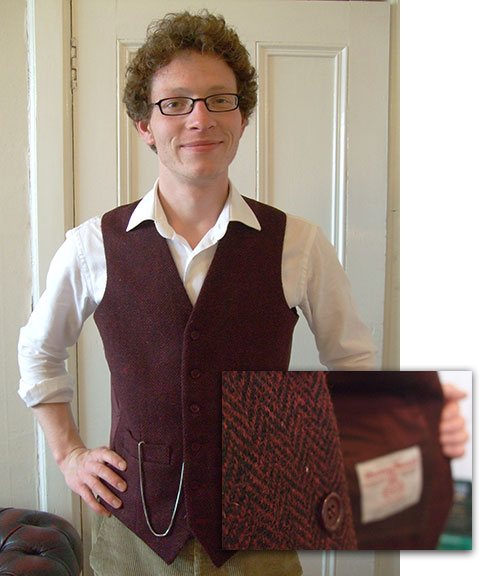
We climbed over the hill to Tarbert where we stopped for a bite to eat and a failed attempt to source ice cream ingredients. Northwards from here the road climbs into the mountains for North Harris before dropping down to the heath and farmland of Lewis. Though the gradients were steep, it was sunny and the views glorious. One of the truly wonderful things about the Hebrides is the density of different environments: the flat lonely Uists compared with Harris that has all the grandeur and sweep of the highlands and then the denser pastoral communities of Lewis. On the run down into Lewis we gained enough momentum to spurn the youth hostel and pitch the tent. From the door of our tent there was a fantastic view looking southwest over the hills of Harris, which compensated for the lack of ice cream.

Day 5: Lewis
Getting out of bed on that fifth day was not the easiest experience. The clouds that had been shimmering bronze the previous evening proceeded to drop their payload on us overnight. Nevertheless a bowl of piping hot oatmeal made with fresh stream water (and probably spiced accidentally with sheep dung) was enough to get back onto the road, that and the thought of ice cream. Thibault encouraged us on straight for Stornoway where we could be sure of getting all the right ingredients and also the opportunity to dry out in a café for an hour or two.
As we trundled down the high street Thibault noticed an archway through the terrace of shop fronts with lengths of tweed hanging from the lintel. There was a wooden board propped up on the ground with “Lewis Loom Centre†daubed on it in peach paint. The archway led through to a small courtyard covered in small dark cobbles with bright new grass growing up between them. A very rusty loom stood by a low doorway through which came the warm glow of an uncovered low wattage light bulb. On entering I was immediately assailed by the antiseptic smell of wool, oil from the looms and a nostalgic kind of dustiness (like a cardboard box of old clothes dug out from the loft to take to Oxfam). The inside of the shop was absolutely stuffed with old furniture: side boards, shelves and tables, arranged, or rather disarranged, into a labyrinth of nooks and crannies. The space between the furniture and low ceiling was stuffed with every conceivable pattern and colour of tweed, ranging in size from off-cuts to neatly folded bales to great industrial rolls. In addition to this, fountains of knitted curios spewed from every drawer of every dresser: hats, socks, gloves. Bunches of tweed bags hung pendulently from nails in the roof beams and every space that wasn’t occupied with wool was filled with antiques, newspaper clippings, photographs of weavers or just bits of driftwood. The owner appeared from behind one of the Doric columns of tweed. I’m not sure how old he was 40s?, 50s?, 60s? His face was crinkled by continuing alternations between expressions of joy and adamance. He seemed to be everywhere at once, one minute lecturing Peter on the history of Stornoway and the next rummaging around in boxes at the other end of the shop to find a tweed hat for Thibault. It was all quite Dickensian really. I bought three different cloths, a woolly hat and some socks.

We also got some advice on the best route to get over to the West coast where we were planning to stay that night. One of the previous landowners/industrialists on the island had built a railway from Stornoway to Carloway. This has later been pulled up and the route tarmaced over making a beautiful straight flat road across the moorland. Since the sky was blue and we were in high spirits Thibault played us a little song as we were riding.
The youth hostel in Carloway is part of a village of restored Lewis blackhouses by the sea. It was a really amazing place to stay, the hostel itself was pretty standard, but the atmosphere was really special. The perfect inspiration for our most audacious ice cream adventure yet. A few miles down the road were the Calanais standing stones, an ancient circle uncovered (from the peat bog into which they were sinking) sometime earlier in the century (and presumably neatened up a bit by well intentioned Victorian archaeologists). It is one of the most iconic sites on the island and the perfect place to give our ice cream tribute to the Scottish islands. What could be more Scottish than Heather honey and malt whisky ice cream (Caol Ila 18-year-old to be precise)? We stirred up the mix (which included an entire pot of honey and a full pint of cream) in the blackhouse, gaffer-taped up the can and headed for the stones. We huddled like a coven of goretex-clad witches round our icy cauldron in the centre of the stone circle, churning the enchanted mixture. As the sun reached its nadir, spreading gold across the sky the handle seized and the can issued forth its creamy goodness. There are few experiences as bizarre as devouring half a gallon of whisky ice cream on a chill spring evening in the middle of the Scottish wilderness. The instinctive desire to eat food in response to cold (to generate heat) conflicting with the resultant decreasing body temperature is so deliciously twisted, contrary and masochistic I think it could only be bettered by making the ice cream chilli flavoured.
Day 6: The Butt of Lewis
After our evening of gluttony and self-induced hypothermia, we were ready for a ride to burn some calories off. We had been told that the north of Lewis was the least interesting part of the island, but I really liked following the chain of old blackhouse villages up the coast, especially in the glorious sunshine. It wasn’t long however before my thoughts turned to food again. “Butt View Stores†provided us with ice and later a petrol station all the necessary dairy. A few miles from the Butt of Lewis we booked into a friendly family run hostel on a farm by the sea. Since the sun was setting we decided to let ice cream wait till the night and set off for the Butt of Lewis. Anyone who visits Lewis would be a fool not to go to the Butt. The far northern seas crashing onto rocks, thousands of sea birds on the sheer black cliffs. We cooked up some tea, took stock of our trip and watched the sun set. As we headed back to the hostel the lighthouse began to burn arcs through though the crisp night air.

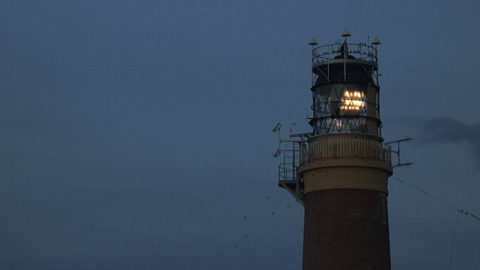
For the final batch of ice cream on the Hebrides we decided to split from our traditional flavour theme and went for spiced choc and chilli (using cayenne and cinnamon). On balance it was a moderate success. My only criticism of this batch was that there wasn’t quite enough bitter intense chocolateiness. My philosophy as far as chocolate ice cream goes is: the blacker the better and from that point of view you can’t beat a high-strength super silky batch of chocolate gelato. The chilli flavour, however, was just perfect for my tastes, enough to have that sting in the tail, the heat after the cool chocolate flavours die away. This is what makes you want to eat more and more to put the fire out, repeating the cycle over and over until your taste-buds are in ice cream ecstasy. A fitting way to end our trip.

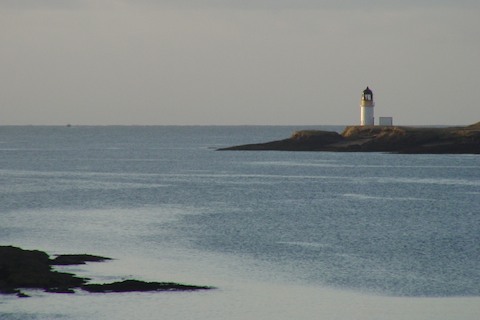


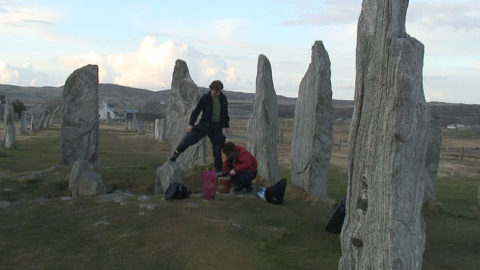
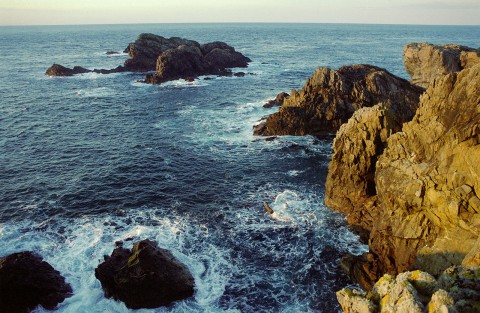

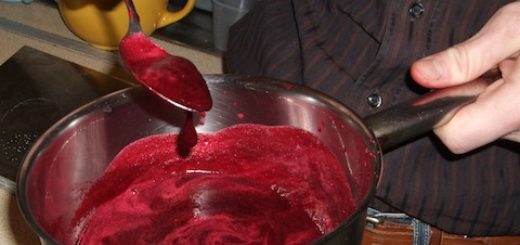


This is amazing. It makes me want to eat ice cream on the top of a mountain, and I’ve never wanted that before.
yo ! i’ve been invited to hundreds of ice cream parties with those guys, we usually dress up as cow boys or leprechaun. Once we got checked by the police, coz they were wondering why we were smashing ice at midnight in the pouring rain, singing along and celebrating the simple things in life !
so think about it, free you mind, take your bike and your ice cream machine ! the world is yours !!!!!!!!!!!!!!!!
Brilliant. Just back from a similar trip including a visit to the lewis loom centre. Your waistcoat is great – where did you have it made?
I bought a whole range of bits of tweed whilst on Harris and Lewis from various places and took them to Walker Slater in Victoria street in Edinburgh to make them into waistcoasts. The chaps who run the shop are great very friendly and relaxed, I recommend them.
How that ice-cream machine works? 🙂
You put the ice-cream mixture into the inner tube with the mixer and the ice in the outer. By mixing the content of the inner tube, you expose it to the low temperature of the outside “tube”, right?
I enjoyed the entire movie at vimeo. Pity it doesn’t last for an hour 😀
This is absolutely brilliant. Seen from Italy, this trip tastes far more exotic than landing on Mars. Can’t say how much I laughed, you definitely made my day, for both your charming writing style and the idea of having ice cream “ovunque e ad ogni costo”. Thank you!